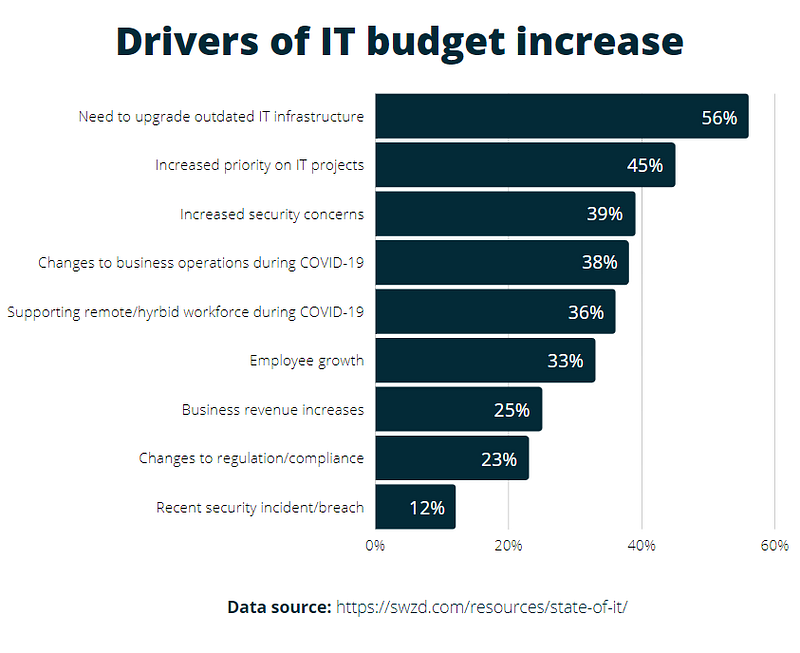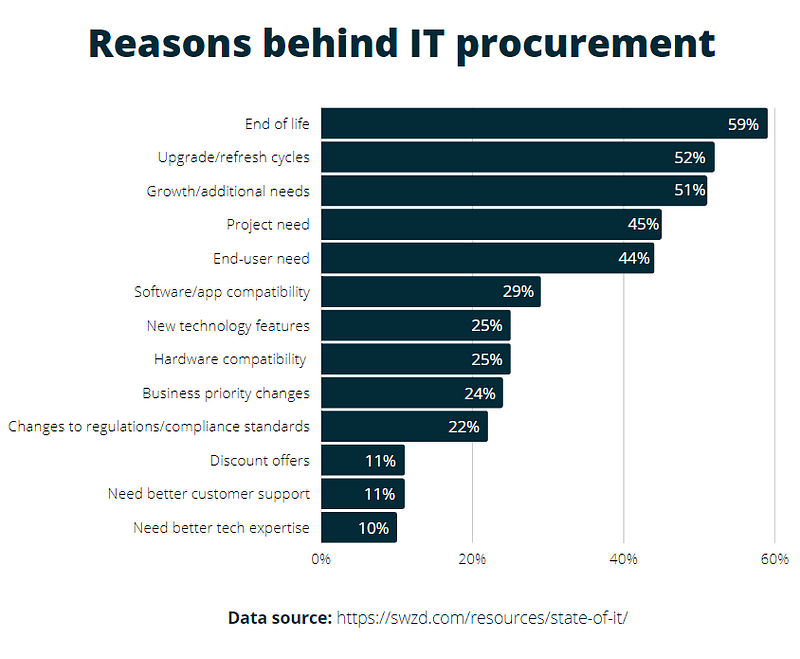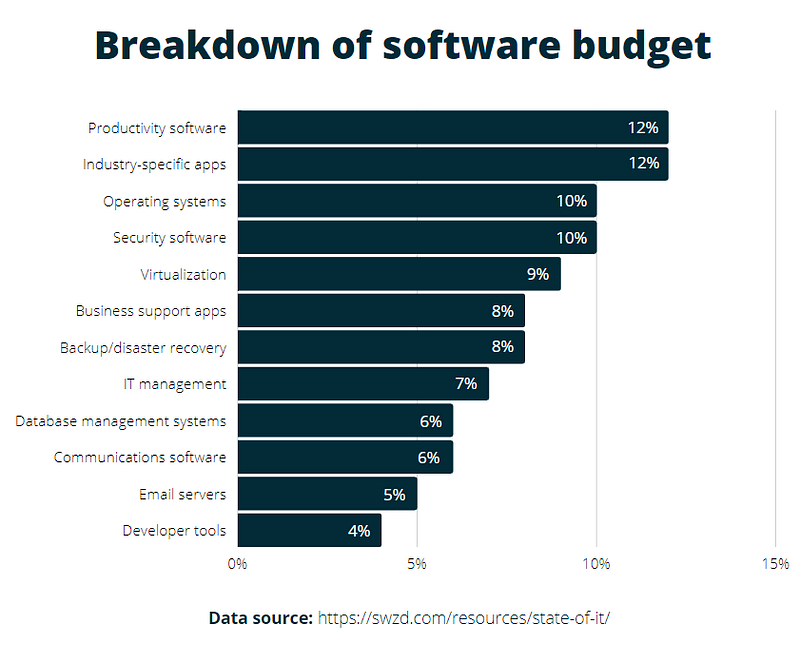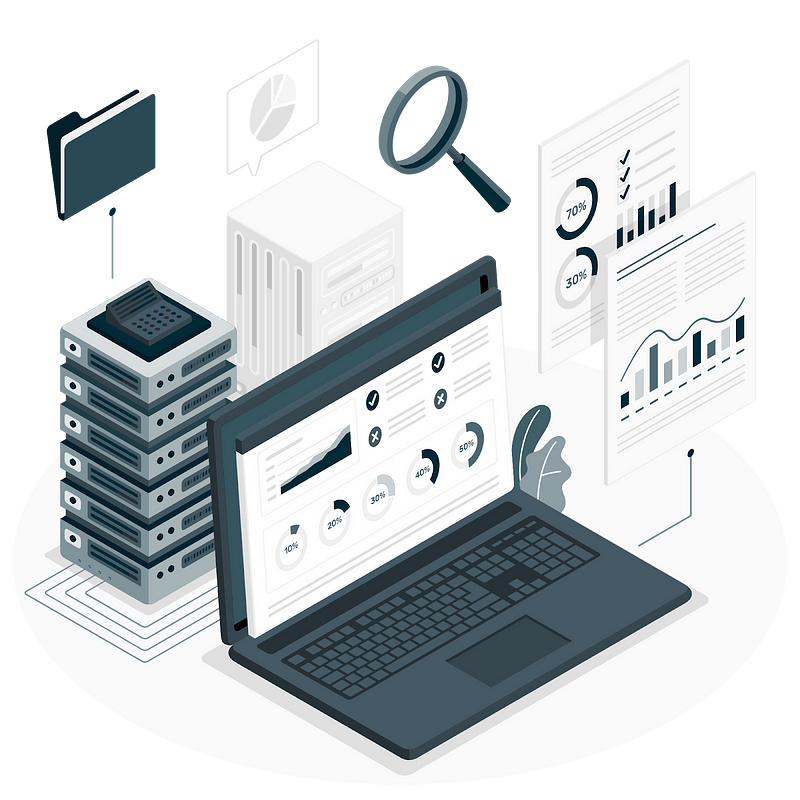According to the latest research by Gartner, global IT spending is expected to reach $4.1 trillion in 2021. Last year, technology spending took a more reactive response to accommodate remote workforces in face of the pandemic. This year, however, CIOs aim to prioritize IT budgets on process innovation and revenue generation as hybrid work comes to the forefront.
“IT no longer just supports corporate operations as it traditionally has, but is fully participating in business value delivery…changing the source of funding from an overhead that is maintained, monitored and sometimes cut, to the thing that drives revenue.”
– John-David Lovelock, research vice president at Gartner
The pressing need for industry-level digitalization across many sectors is perhaps the primary driver behind increasing IT costs. Let’s take a deeper look at additional reasons that attribute to burgeoning IT budgets!

As shown in the infographic above, 56% of the surveyed organizations say that updating legacy systems to facilitate digital transformation is the key reason behind increased IT costs.
Many businesses continue to invest in advanced technology to bolster their cybersecurity systems, meet the ever-changing compliance requirements, and kickstart new projects at the enterprise level.
Furthermore, there’s been an increasing focus on adapting business workflows to meet the remote/hybrid needs of the post-pandemic workforce.
Gartner predicts that the global installed base of IT devices including laptops, PCs, tablets, and mobile phones is estimated to reach 6.2 billion units in 2021 — with rising demand for 4G/5G devices. Similarly, businesses are also purchasing more enterprise software in business innovation efforts.
This translates into a complex IT infrastructure that is hard to track for many businesses. It is, therefore, essential to optimize cost management of IT assets so overall benefits outweigh the expenses.
5 key ways for IT cost optimization
Below, we detail five primary methods that can be used to minimize and control the ever-expanding IT budgets of growing enterprises.
1. Centralize and consolidate your technology landscape
The technology landscape of businesses grows as they expand their operations. This means a widespread network of disparate data centers, IT devices, and software applications.
Consolidation, at its core, refers to simplifying and centralizing all the disparate systems within an enterprise. Many companies now engage in data center modernization to centralize the information stored within multiple data centers, leading to 10 to 20% cost savings.
It is recommended that businesses unify management of their IT endpoints — both remote and on-premise to enable a hybrid work environment. Nowadays, enterprises such as Microsoft also develop integrations on server-less cloud computing platforms like Amazon Web Services to consolidate the various applications that they use.
Data and system consolidation can help a business in the following ways:
- Tactical: It streamlines operations and centralizes data storage and the overall management of your workstations, servers, and networks; thereby reducing IT management costs.
- Operational: By standardizing assets and removing redundant workflows, consolidation also enhances the productivity of your IT team. Comprehensive visibility into your IT landscape helps with reduced downtime instances and quick problem management and disaster recovery.
- Strategic: You can also quickly adapt to the future growth needs of your organization with a centralized, scalable IT environment.
All these benefits reduce the process complexities in the tech infrastructure and boil down to lower IT costs.
2. Implement a cloud-first strategy
Cloud-first strategy means prioritizing cloud-based systems over on-premise ones while making strategic decisions. It also refers to shifting from legacy in-house systems to easily accessible cloud platforms so relevant company data can be accessed from anywhere, at any time.
Cloud adoption is even more vital in the post-pandemic work environment to support oversight of the remote technology assets.
A cloud-first approach may help your organization by being:
- Cost-efficient: It saves you the extra time, money, and resources you may need to spend building hardware for on-premise systems.
- Scalable: Cloud hosting platforms are extensible and easy to scale during the time of expansion as opposed to in-house systems that require a complete infrastructural overhaul.
- Recoverable: Physical databases may fail due to hardware crashes, natural disasters, or theft, etc. Cloud databases, on the other hand, are regularly backed up and easily recoverable with zero downtime.
To increase cost efficiencies over time, you can also carry out periodic cloud governance and risk checks to solidify your cloud infrastructure and avoid costs resulting from poor governance.
3. Improve procurement and sourcing capabilities

As illustrated in the infographic above, most enterprises procure new technology to replace older infrastructure that is nearing retirement, upgrade or refresh their existing assets, facilitate newer projects and employee needs, and the like.
However, having no mechanism to forecast the optimal demand of technology assets may lead you to overspend for unnecessary assets or cause a technology shortfall in other cases.
It is key to streamline your IT procurement processes such that they integrate procurement planning, budgeting, asset lifecycle management, and disposal into one complete solution. An ITAM tool typically comes equipped with the following capabilities so you can:
- Get a quick overview of ongoing and pending asset procurement schedules
- Forecast asset needs according to past utilization patterns
- Verify purchase requisitions made by employees
- Communicate with vendors
- Manage purchase contracts
- Track the useful life of procured equipment
- Dispose of obsolete assets from the system
Complete control of your procurement processes from purchase to retirement lowers equipment holding costs and ensures optimal spending.
4. Optimize software licensing management capabilities
Owing to the hybrid model, many businesses are now increasingly investing in productivity and collaboration tools as well as cybersecurity software. Many agile companies are also allocating a significant part of their IT budgets for dedicated IT asset management.

Managing a variety of software tools without keeping track of their licensing needs may lead to non-compliance and consequent legal fines and true-up costs. You can save up on these expenses by carrying out software license management.
Document, track and optimize your total licensing costs with a robust SLM tool. Monitor the compliance, payment, and renewal status of each of your subscription licenses. You can also run detailed reports to identify underutilized or unassigned software applications and revoke licenses of unused copies to avoid overspending your software budget. By monitoring your licensing framework, you reduce IT costs and remain compliant with international regulations.
5. Deliver valuable insights for strategic IT management
When it comes to tightening the overall budget, the senior management is primarily interested in relevant and valuable information.
Here are five key questions that stakeholders ask to make strategic budgetary decisions:
- Business service: How does the allocated IT budget provide value to different business units especially sales and customer service?
- Project planning: What is the approach for prioritizing projects and their respective resource allocation? Are post-implementation costs included to determine the overall IT spend for each project?
- Chargeback: Does the technology department charge different business units and branches for the assets it checks out to them?
- Performance metrics: Which performance metrics are tracked to determine the success of the IT implementation strategy?
- Benchmarking: How does the performance of our technology compare with that of our peers? What are the reasons for differences, if any?
A key aspect of IT cost optimization is to run detailed analyses of your processes and cost patterns, derive valuable insights from them, and regularly communicate them to the top management.
This gives a holistic overview of how the IT budget is adding value to the business and enables informed decision-making for the future.
IT cost optimization best practices
Here are some best practices you can follow to make IT cost management easier.
1. Make all IT-related costs transparent

Gartner’s surveys show that almost 62% of CIOs believe that there is inadequate transparency of total IT costs. Many are unaware of the Return on Investment and Total Cost of Ownership of their IT landscape. Unless you have a complete picture of your true costs, you cannot optimize them.
According to the research done by PEI, you can divide your technology expenses into the following categories.
- Cost of IT labor: Annual salary, taxes and insurance (social security, FUTA, workers compensation, etc.), benefits (health/dental insurance, paid time off, perks, etc.)
- Administrative expenses of IT staff: Training and seminars, travel, government, and security compliance
- Cost of IT contractors: Third-party vendors that offer support like managed services, database administration, programming, and the like.
- Other expenses: Cost of purchasing and maintaining computers, mobile devices, network devices, and servers, etc.
2. Benchmark your spending
Benchmarking your budget is a time-tested way to control your expenses and adjust them accordingly. You can benchmark your IT spend in the following ways:
- Benchmarking against published industry standards is perhaps the easiest way. You can access industry metrics from research websites like Computer Economics, Gartner, Forrester, etc.
- You can also benchmark relevant metrics against selected peers or competitors. This is a slightly harder approach however it offers a sound comparison.
- Another option is to benchmark metrics across internal business units, departments, or branches to gauge how your technology assets add value to different units within your organization. This typically helps multinational corporations that have operations spread across multiple geographies.
3. Regularly monitor your cost optimization strategy
Note that IT cost optimization must not be a one-and-done effort but an ongoing discipline. Try not to make sudden budget cuts in response to crises or projects that suddenly call for a greater chunk of the yearly budget. This may impact the development needs of your technology department.
Alternatively, a better approach is to carry out periodic cost-benefit analyses of all initiatives that require IT services. You can list the initiatives and sort them in terms of priority and value and allocate the budget to these initiatives accordingly.
“All organizations attempt to optimize IT costs but those that do it best — focus on cost optimization as an ongoing discipline, not as a one-off exercise,”
– Jim McGittigan, research VP at Gartner
4. Invest in an ITAM solution

When it comes to reducing IT costs, CIOs often overlook the idea of dedicated asset management. Automating IT asset management can help you achieve cost savings of 10% to 20%.
Invest in an efficient ITAM solution that comes equipped with unified endpoint management capabilities so you can manage your tech landscape from a single space. Track your SAM inventory, monitor license expenses, and compliance status.
An ITAM solution also offers procurement management so you can forecast inventory needs and manage vendors, purchase orders, and contracts. Run detailed reports and track metrics of your preference to update your senior management on the ultimate value that your IT budget brings to the organization.
Read more: Recession Planning: A CIO’s Guide To Reducing IT Costs with AssetSonar
Optimize your IT budget with AssetSonar
AssetSonar is the leading cloud-based IT asset management software with endpoint management, software license tracking, hardware lifecycle management, and reporting capabilities to help you reduce your tech spend and get the maximum out of your IT budget.
Sign up today for a free 15-day trial.
For more assistance, drop us an email at support@ezo.io. You can also visit our blog for detailed support posts.
Join the Conversation: Twitter | Facebook







